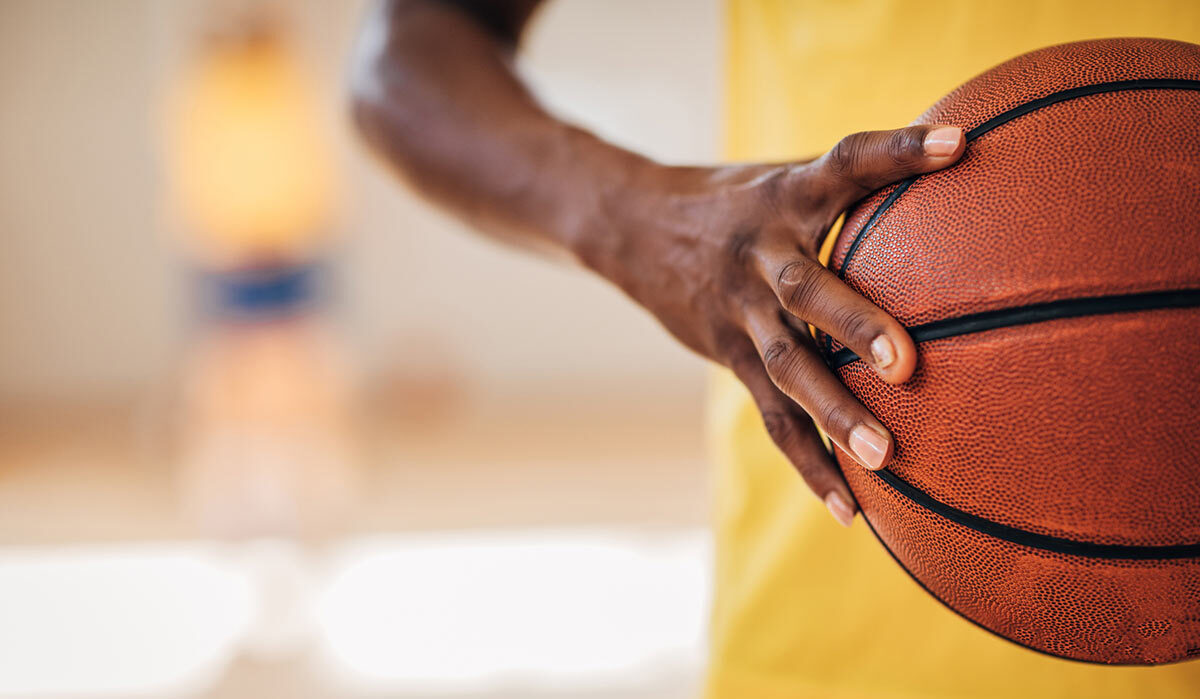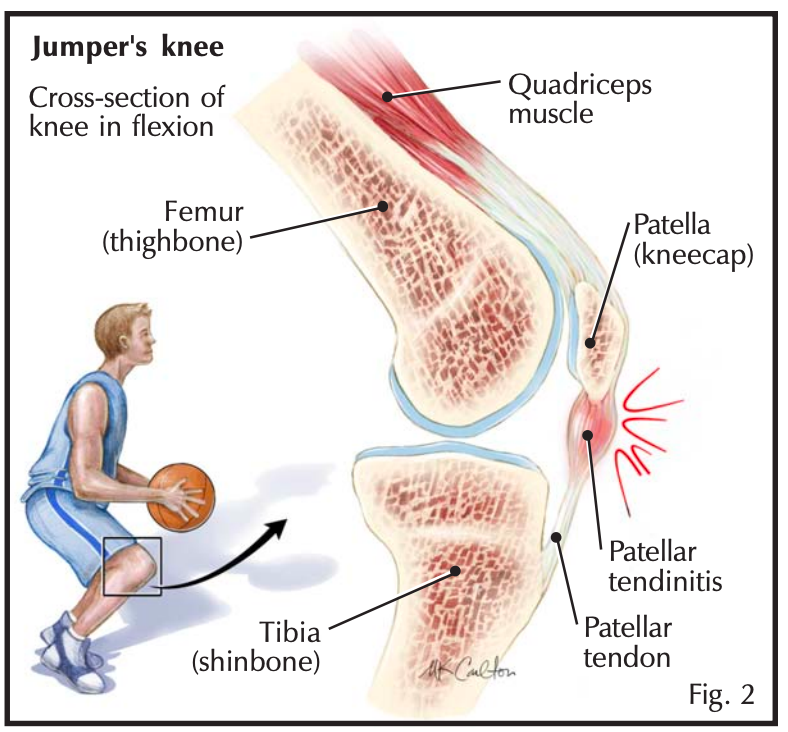
Basketball is an exciting, fast-moving sport. Unfortunately, what makes the game exciting to watch and exhilarating to play also makes it a high-risk sport for knee injuries. Running with sudden stops, cutting side to side, jumping, and pivoting can injure your knee. Although there are risks of knee injury, it’s still a great game, so before you jump in, you should know the risks and what you can do to prevent injury.
The largest joint in the body, the knee, is made up of the lower end of the femur (thighbone) and the upper end of the tibia, or shinbone. The patella, or kneecap, slides in a groove at the end of the femur.
 Ligaments at the end of the femur and tibia connect the bones and help stabilize and support the knee (Fig. 1). Tendons connect the muscles to the bones, and the cartilage inside the joint helps to cushion and absorb shock to the joint and to give stability to the knee.
Ligaments at the end of the femur and tibia connect the bones and help stabilize and support the knee (Fig. 1). Tendons connect the muscles to the bones, and the cartilage inside the joint helps to cushion and absorb shock to the joint and to give stability to the knee.
A sprain or strain can occur when there is a direct blow to the knee or when there is a sudden, stressful movement that affects the knee. A sprain or strain can also develop from overuse of the joint or when you place too much stress on the knee for a long period of time. Often, with a sprain or strain the tissues become irritated, causing pain and swelling.
Sprains
A sprain is a stretch or tear of a ligament. More serious sprains involve complete tears of one or more of the knee ligaments. A common knee sprain involves the anterior cruciate ligament (ACL) (Fig. 1). Changing direction rapidly or stopping abruptly while running can cause the twisting motion that tears the ACL.
If you sprain your knee, you may hear a popping or snapping sound at the time of injury. Afterward, pain seems to come from within the knee, especially with movement. You will not be able to bear weight on that leg, and you can experience swelling and fluid behind the kneecap. You may also hesitate to place weight on the knee because it feels loose or unstable.
Strains

Strains are defined as a partially or completely torn muscle or tendon. With knee strains, you may feel symptoms similar to a sprain and may see bruising around the injured area.
Patellar tendinitis, or jumper’s knee, is a common strain that usually results from overuse. Jumper’s knee is an inflammatory condition that causes pain in the front of the knee. The extensor mechanism, which includes the quadriceps muscle and patellar tendon, connects the patella (kneecap) to the femur (thighbone) and the tibia (shinbone) (Fig. 2). Patellar tendinitis begins as inflammation of the patellar tendon where it attaches to the patella. It can worsen by continual tearing or from degeneration of the tendon.
Treatment
You should rest your knee at the first sign of a sprain or strain. Immediately after injury, apply the RICE (rest, ice, compression and elevation) method. You should rest your
knee as much as possible, apply ice packs for a couple of days to bring down the swelling, use compression, such as an ACE bandage, and elevate the leg on a pillow. For inflammation and pain, your doctor may prescribe anti-inflammatory medications such as aspirin or ibuprofen.
Treatment for knee injuries, such as severe sprains or strains (where a ligament or tendon is more seriously stretched or torn), may involve using a knee splint, immobilizer, or cast, and using crutches for a few weeks or months.
Depending on the injury, your doctor may suggest rehabilitation for your knee injury. Working with a physical therapist, you will do specific exercises designed to take your knee through its range of motion to prevent stiffness and scarring as your knee heals. You may also need to do regular exercises to strengthen the muscles surrounding the knee.
Injury prevention
To prevent knee injuries, always wear appropriate protective equipment during practices and competition. Kneepads and shinguards will help to protect your knee from injury. You’ll also want to make sure you wear supportive shoes that are in good condition and are appropriate for the basketball court.
During workouts, always warm-up and cool down, and remember to increase your training intensity slowly. You might try weight lifting to strengthen your muscles and use stretching exercises to improve your flexibility because strong flexible muscles help support and protect joints. Warm-up with jumping jacks, a stationary bike, or running or walking in place for 3 to 5 minutes. Then slowly and gently stretch, holding each stretch for 30 seconds. After an intense workout, practice, or competition, slow down your heartbeat and stretch your muscles again to cool down. Do not suddenly increase the intensity or duration of your workout because it can lead to an overuse injury. If you play only one sport, maintain coordination and balance by training year-round even if it’s at a lower intensity than during your competitive season.
The way you move can also help to prevent knee injuries. When you jump, bend your knees when you land to take pressure off the ACL. When you cut laterally or pivot, crouch at the hip and bend your knees to reduce your chance of ligament injury.
Never play through the pain of a sprain or strain. A minor injury can become a more serious injury that requires surgery if left untreated. A minor sprain or strain may keep you off the basketball court for a few weeks, but a major injury may keep you out of the game the entire season. Always see your doctor at the first sign of knee injury. You’ll be glad you did.
Author: Glenn C. Terry, MD | Columbus, Georgia
Last edited on October 18, 2021